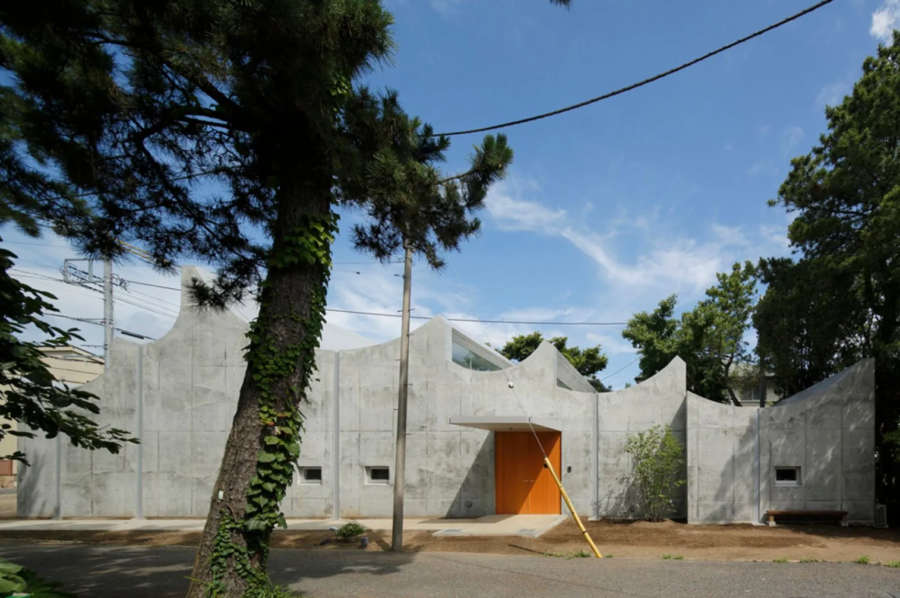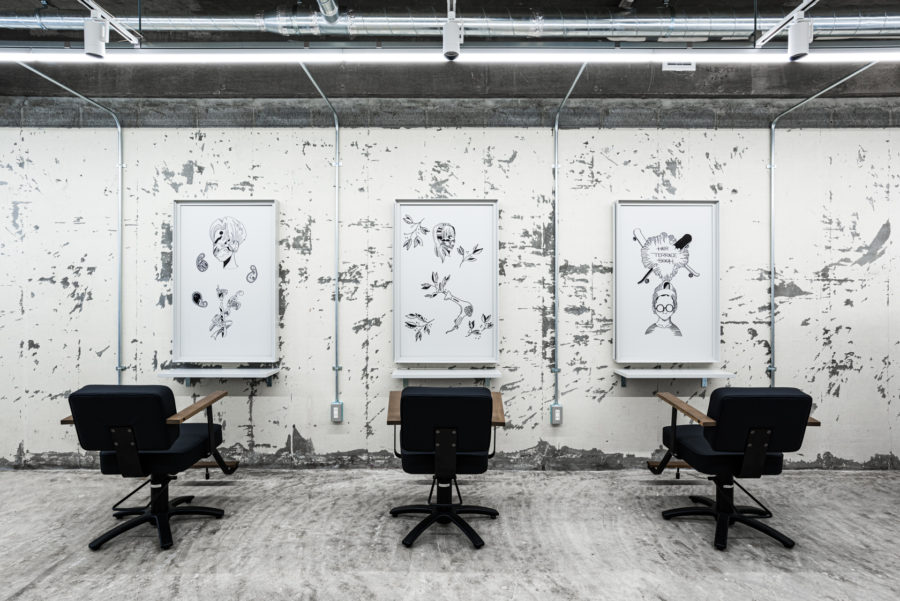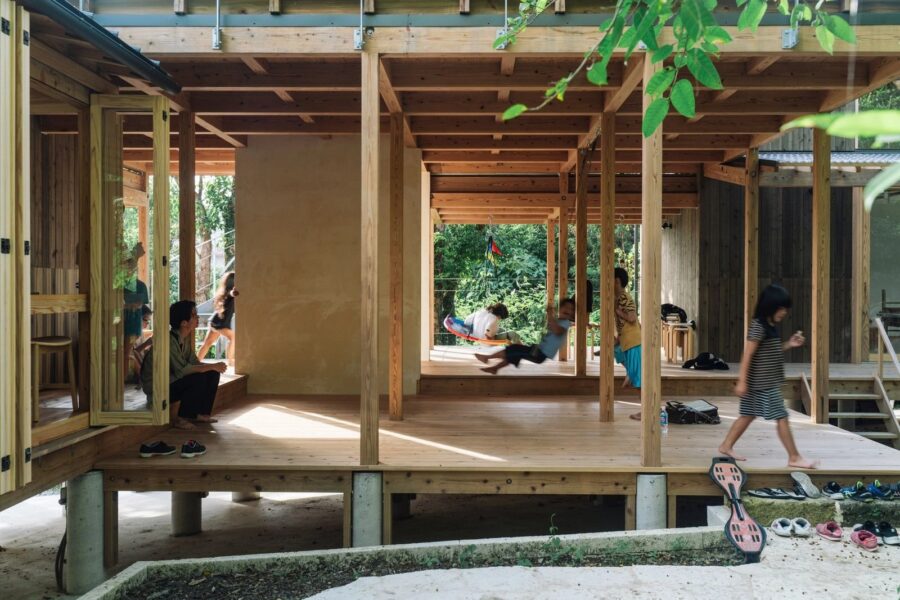広島特有の斜面に建つ、4人家族のための家である。
敷地は南北に細長い形状をしており、敷地の北側は幅の狭い道路に接し、南側は高さ10メートルを超える崖地となっている。周り一帯は、北側の道路に沿って、古くからの住宅が密になって建ち並んでおり、道路は住民たちが使う車が時おり通る程度で、近所に住む子供たちが道路で遊んでいる日常風景がここにはある。その一方で、南側は崖を挟んだ先に山々が連なり、北側の高密度な住宅街とは対照的に、豊かな自然が広がっている。この地を初めて訪れたときから強く印象に残っていた、計画地の南北における「環境の二面性」を、プランニングに取り込めないかと考えた。
住宅の外形は、建ち並ぶ周辺の住宅にならい、2階建ての切妻屋根という標準的なかたちをベースにしているが、南側斜面に直交する角度を屋根の棟の軸線として引用することで、棟が中央からずれた切妻型のファサードとなっている。形式化した切妻の型を崩し、妻面の2つの対照的な環境を結ぶ意識を強めることを意図したデザインである。
平面は、長方形をベースにして、棟の軸線に合わせて一部が飛び出たような、変形の六角形とした。これは、建物を配置することでできる敷地の余白(建物のそと)が、残された場所とならず自律的にふるまうことを促している。また、この小さな角度の操作は、建物のうちでは「机」「階段の上り口」「キッチンの作業台」「トイレの本棚」などの窓辺の行為を生み出すことで、建物の内と外を等価に扱うことができると考えている。
壁は設けず、スキップフロアとすることで、生活空間を分けた。それらのフロアを行ったり来たりするように、階段と生活空間をちりばめた。南北の立面には、それぞれの環境を取り込む大きな窓を設けているため、日常的に、北側の住宅街と南側の自然という、2つの環境を経験するような構成となっている。
小さな住宅の中に、どのようにして違いの大きい2つの環境を折りたたみ、心理的なおおらかさを獲得するかを考えた住宅である。(長谷川欣則+堀越ふみ江)
A House that incorporate the duality of the environment inherent in the planned site into their design
It is a house for a family of four built on a steep slope unique to Hiroshima.
The site is elongated in the north-south direction, the north side of the site is connected to a narrow road, and the south side is a cliff with a height of more than 10 m. The north side of the site is in contact with a narrow road, and old houses are densely built along the road. The road is just for the residents’ cars to pass, and the children living in the neighborhood are playing there. On the other hand, on the south side of the site, the mountains are connected to the end of the cliff, and the nature contrasts with the high density residential area on the north side.
We considered incorporating the “two-sided nature of the environment” on the north and south sides of the site into this house. This house is based on the standard form of two-story and gabled roof with reference to the surrounding houses. Furthermore, by adjusting the angle of the ridge to an angle perpendicular to the slope, a gable type in which the ridge is offset from the center is created. This breaks the formalized gable mold and strengthens the sense of connecting the two contrasting environments. The plane was based on a rectangle, and was a deformed hexagon, with the ridges aligned with the ridges.
This aims to act autonomously, avoiding that the outside of a building becomes a left over place. Furthermore, inside the building, this small angle of operation produces actions around the window such as “desk”, “upstairs of stairs”, “workbench of kitchen” and “bookshelf of toilet”. In this way, the inside and the outside of the building are created to be equivalent. In this house, space is divided by skipping floors instead of walls. The south and north faces have large windows that open up their environment.
A family lives while moving between two environments, a residential area on the north side and a nature on the south side, on a daily basis. We were thinking about how to get the psychological breadth by folding the two largely different environments into a small house. (Yoshinori Hasegawa + Fumie Horikoshi)
【PARA house】
所在地:広島県広島市
用途:戸建住宅
竣工:2018年
設計:ウエノアトリエ / UENOA
担当:長谷川欣則 堀越ふみ江
構造設計:永井拓生 / Eureka
施工:株式会社沖田
撮影:UENOA
構造:木造
建築規模:地上2階
敷地面積:207.62m²
建築面積:57.02m²
延床面積:112.87m²
設計期間:2016.06-2017.12
施工期間:2018.01-2018.06
【PARA house】
Location: Hiroshima, Japan
Principal use: Residence
Completion: 2018
Architects: UENOA
Design team: Yoshinori Hasegawa, Fumie Horikoshi
Structure engineer: Takuo Nagai / Eureka
Contractor: OKITA Co.,Ltd
Photographs: UENOA
Structure: Wood
Building scale: 2 stories house
Site area: 207.62m²
Building area: 57.02m²
Total floor area: 112.87m²
Design term: 2016.06-2017.12
Construction term: 2018.01-2018.06








